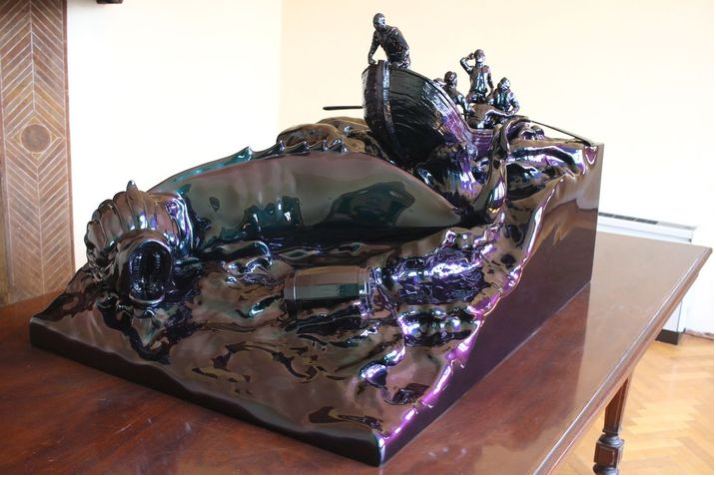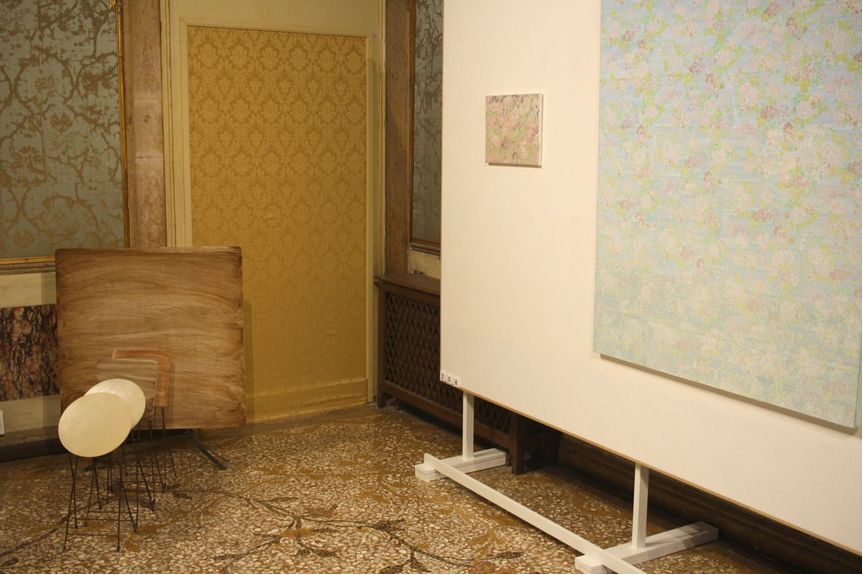
R
E
V N
E
X
T
Beyond the leafy Giardini and the pebbly Arsenale of the Venice Biennale lie numerous exhibitions, some of which are accorded the official status of a “collateral exhibition” and others that rise to attention on their reputation—most notably those at Palazzo Fortuny, Fondazione Prada and Fondazione Querini Stampalia. Among the contemporary art tourists that flock to Venice every two years, there were those who elected to see Damien Hirst’s horrific, plagiaristic kitsch, taking place in a massive all-for-sale exhibition titled “Treasures From the Wreck of the Unbelievable,” at Christie’s owner Francois Pinault’s two spaces, Palazzo Grassi and the Punta della Dogana. I would like to imagine that Hirst’s monstrosities are only there to fuel an appreciation of Christine Macel’s sincerity-woven central exhibition “Viva Arte Viva” and the many thoughtful national pavilions. Among the dozens of other exhibitions in Venice are the “collateral exhibitions” that could also be considered the “national pavilions” of Taiwan, Hong Kong, and Macao—these are given peripheral designation because the People’s Republic of China claims those areas as its own. There are also several national pavilions that have yet to secure positions inside the Arsenale (the Giardini is already at maximum capacity), or have opted for the marginally less expensive real estate of off-site locations. So here’s a look at the notable outliers of the 57th Venice Biennale.
TEHCHING HSIEH, One Year Performance, 1980–1981, installation view. All photos by HG Masters for ArtAsiaPacific.
Taiwan Pavilion: Tehching Hsieh
One of the best national presentations, year in and year out—even if it is officially designated a “collateral exhibition”—is the Taiwan Pavilion, organized by the Taipei Fine Arts Museum. Even by its own past standards, the Taiwan Pavilion’s spotlight of Tehching Hsieh, “Doing Time,” curated by Adrian Heathfield, was superb. Hsieh is best known for his “One Year Projects,” two of which were featured in the pavilion: his 1980-81 project in which he punched into a worker’s clock every hour for one year; and his year spent entirely outdoors between 1981 and 1982. To represent the former was an installation of all the time cards, plus a 16-mm film documenting his clocking in. His year spent outdoors is recorded through a series of daily maps of New York, annotated with Hsieh’s walking routes and notes about what he ate and who he met, as well as the clothes he wore that year. For those who already admire Hsieh’s practice, the pavilion’s added bonus was that it was the first public presentation of documentation of three works created in 1973, while the artist was still in Taiwan. There were photographs of road repairs that look like abstract paintings; a re-staging of a piece in which he exposed photographic paper to the elements; and stills of a recording he made of himself jumping out of a second-story window—an act which resulted in his breaking both his ankles.
Hong Kong Pavilion: Samson Young
Samson Young’s multi-part project for the Hong Kong Pavilion, “Songs for Disaster Relief,” stems from the artist’s interest in the bygone popularity of “charity singles,” and the bizarre cultural misinterpretations that the genre has produced over the decades. In one video, the classically trained composer commissioned the choir of the Hong Kong Federation of Trade Unions, a pro-Beijing group, to sing We Are the World, a saccharine 1985 charity track by 37 artists for humanitarian aid in Africa, in a “muted performance” so that the song is almost whispered rather than sung. A larger multi-room installation imagines the living space (dubbed a “palazzo,” because it’s Venice) of a protagonist named Boomtown Gundane. The character was, supposedly, the producer of the song Yes We Do, by a Cape Town group called Plaster Cast, which is a retort to the charity supergroup Band Aid’s 30th-anniversary re-release of its already misguided song for Africa, Do They Know It’s Christmas. As it turns out, Gundane was a satirical hoax, but Young imagined a living space for him anyway, complete with televisions playing strangely dislocated animatronic figures. (For example, one is wearing a kilt and moving across a green screen.) A bronze-like sculpture, encased in a vitrine in an adjacent room, was a mash-up of the Winged Victory of Samothrace, a bust of Pythagoras, a space station, Ronald Reagan and a bugle—but seemed out of place, or only very tangentially related to the “charity single” theme with its references to the 1980s, even when compared to the “gold record”-like collages on the walls. But there were larger questions that felt unresolved in “Songs for Disaster Relief.” For example, what exactly is at stake in these works and what do they discuss, aside from reveling in the grotesque neocolonialism of the long outdated charity-single genre?
Iraq Pavilion: “Archaic”
Curated by Ruya Foundation director Tamar Chalabi and Paolo Columbo, the Iraq Pavilion was titled “Archaic,” in reference to the country’s ancient history and its modern and current governance, which, in the curators’ words, “is arguably as ‘archaic’ as its ancient heritage.” Located in the wood-paneled library of the Palazzo Cavalli-Franchetti near the Accademia bridge, “Archaic” featured eight modern and contemporary Iraqi artists, plus a display of 40 ancient artifacts from the Iraq Museum, some of which were recovered after the infamous 2003 looting of the museum during the United States military invasion. Like the artifacts, a majority of the artworks were shown in glass-topped vitrines, which wasn’t the most commodious display system but suited the setting and theme. The chronological display begins with works by the co-founders of the Baghdad Modern Art Group in 1951, Jewad Selim and his protégé Shakir Hassan al-Said, who are the “antiquity” to today’s artists, having been schooled in an international modernism genre that they then channeled into their own anti-colonial art-making philosophies. Sadik Kwaish Alfraji’s books and video animations evoke both ancient drawings and utilize Iraqi school textbooks, while Nadine Hattom’s installation Until the River Winds Ninety Degrees West (2017) incorporates six family photographs of Iraq in the mid-20th century with small sculptures and images related to the Mandaeans (a southern Iraqi community that reveres John the Baptist), as well as those of rituals and ceremonies such as baptism and marriage.
Installation view of “Intiution” with paintings by SHOZO SHIMAMOTO (background, left) and PARK SEO-BO (background, right).
Palazzo Fortuny: “Intuition”
The Axel & May Vervoordt Foundation is presenting its sixth and final exhibition in Venice at the Palazzo Fortuny; these exhibitions have gained a cult reputation for their sweeping presentations of art history and for the exquisite settings in the former atelier of artist and designer Mariano Fortuny. “Intuition” began with sandstone sculptures from the 4th to 3rd millennium BCE, which had been unearthed in France. This was paired with Jean-Michel Basquiat’s standing figure Versus Medici (1982). The audacious displays of new and old, sacred and profane, surrealist and realist, continued across the building’s four floors and many rooms, each curated through unabashedly sensuous visual affinities between the historic palazzo and artworks. Anish Kapoor’s hollowed-out, all-white orb White Dark VIII (2000) commands a room whose other occupant is a medieval sculpture—a daring pairing. The curatorial tactic is often purely visual. There’s a black-painted, black-carpeted room of nearly all-black artworks and another room of purely brass-colored works. Korean artists of the Dansaekhwa movement and postwar Japanese artists were well represented among the many works of 20th-century abstract painting. Sensuous, fun and serious—though not necessarily all at the same time—“Intitution” is an experience not to be missed, and the last one of its kind at Palazzo Fortuny.
Shezad Dawood: “Leviathan”
Shezad Dawood has announced that he’s embarking on an ambitious ten-part film cycle, “Leviathan”—to be completed in the next three years, no less—about a cast of characters inhabiting an imagined future after “a cataclysmic solar event.” He is off to an impressive start, after premiering the first two films at an exhibition during the Biennale; the third film will arrive in Venice in September. (Yes, people who visit Venice in September will see something that the scenesters of May won’t.) Dawood has long been interested in experimental film and has a virtuosic ability to appropriate and transform avant-garde techniques into his own. The two parts of Leviathan showing in Venice are some of his most captivating works to date. The first follows a character named Ben, and is, crudely put, a psychotic-seeming interior monologue paired with aquatic images of divers. The second part narrates the survival experience of a woman named Yasmine, whose defining personality trait is that she enjoys urinating in her jeans. She meets another survivor, a male, and views him as sexual prey; together, they visit a floating research platform where yet another survivor has taken refuge and has descended into madness. The relatively short films, packed with evocative monologues and imagery, were displayed alongside related textile works and sculptures by Dawood. This introductory exhibition bodes well for the series—though the same can’t be said for the depictions of humanity in the films.
Liang Yuanwei: “Behind the Curtain”
Organized by K11 Art Foundation and curated by Loic Le Gall, “Behind the Curtain” featured new works by painter Liang Yuanwei, who is known for her skillful reproductions of the textures and designs of fabrics. Liang’s paintings neatly collapse the traditionally “masculine” prerogatives of abstract painting with the “feminine” associations of textiles, while also inverting the hierarchy of fine art and crafts, by using the former to imitate the latter. Along with presenting Liang’s paintings, “Behind the Curtain” included an earlier project of hers, umustbestrong (2004–06), in which the artist typed, with a typewriter, the titular phrase 44 times a day onto toilet paper for two years, until the rolls were filled. Another installation, Early Spring – 1 Table 4 Stools (2010), uses common domestic and restaurant tabletops as a surface on which to paint monochromatic abstractions in broad, wash-like strokes. These works suggest the more experimental approaches that her practice could have taken, or still could take. Liang’s paintings are certainly a unique signature, with the 2017 paintings drawing on muted brown and blues that echo the faded glory of Venice, while also remaining comfortably within the established genre of painting. A glimpse of the artist’s avant-garde works, however, compels a desire to see more experimental directions in the future.
HG Masters is editor-at-large of ArtAsiaPacific.
To read more of ArtAsiaPacific’s articles, visit our Digital Library.









